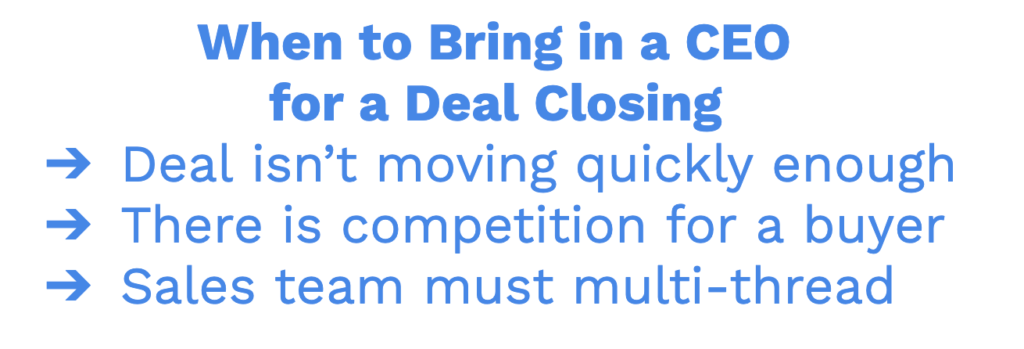Imagine your sales team is extremely close to signing an important deal with a prospect. Everyone’s anxious to get the contract signed and the gong in the corner of the office is ready to bang. But then, unexpectedly, the buyer pushes back, not sure if this is the best time.
At that moment, with revenue in the balance, the team has to convince the prospect that your product is indeed the right fit and that this soon-to-be customer is a priority. It’s time to bring in your CEO to close the deal.
The idea is “to let a client know their best interests are in mind,” says Steven Wernke, director of sales at ZoomInfo.
Why Bring in the CEO
Asking your CEO to step in can make a would-be buyer feel important and provide reassurances about the deal — particularly if executives at their company are involved.
Case in point: This past Memorial Day, a sales team at ZoomInfo had a closing that looked to be in jeopardy.
“[The prospect] just got last-second cold feet when we had this all buttoned up and it was supposed to go,” recalls Lou Wolf, vice president of sales. “We needed that new voice and we needed that CEO title to get [the buyer] to open up.”
So, he asked ZoomInfo CEO Henry Schuck to call the buyer to assure them the investment was a sound choice. Schuck made the call and the buyer was open with him about what their concerns were. He was able to get insight that wasn’t shared with the sales rep in just a two-minute call.
The sales team was able to solve the issues for the prospect. Once the buyer saw quick action and felt the sales team was on top of the concerns, the contract was signed that evening.
The role of the CEO during these deal-closing moments is to confirm that both sides are in agreement about the product. It ensures that clients feel supported about the deal at all levels of their organization.
CEO involvement can also be advantageous when your sales team is dealing with another CEO at the client company. Having one executive talk to another moves the deal along.
“Hopefully it makes [the client’s] CEO feel good that we really care about having their business,” Wolf says.
When to Bring in the CEO
The best time to call in a CEO is when a deal is close, but the client needs a nudge to get the contract signed.
This can occur when a signing is agreed upon but isn’t moving fast enough or if multiple sellers are competing for the same customer. CEO involvement can also be beneficial when sales teams begin multi-threading up a buyer chain.
Just as important is knowing when not to ask the CEO to step in. Don’t make this request for tough prospects who are resistant or when a deal has devolved into a situation that can’t be fixed.

How to Bring in the CEO
Depending on the size of the client, CEO involvement can consist of an email message, a phone call, or even a Zoom meeting. The CEO should make clear that the deal is important and offer any necessary help to get the contract signed. As with all sales efforts, personalization is key.
The CEO can reiterate the business challenges that brought the prospect to your product initially or bring up the client’s mission statement.
Calls or Zoom meetings are generally preferable to an email message, but that isn’t always possible. Another option is to shoot a video clip from the chief executive. “I’ll send a one-minute video about the deal and how excited our CEO is about it,” Wolf says.
CEO involvement works
As companies grow, sales teams may need to reserve their CEO requests for enterprise clients or for cases when an executive at the buying company needs prodding.
“It’s just a different voice hitting them,” Wolf says. “And it works.”
When companies are competing for the same customer, sellers that get their CEOs involved stand a greater chance of closing a deal.
Uncover data that gets you to the finish line quicker with deals.

